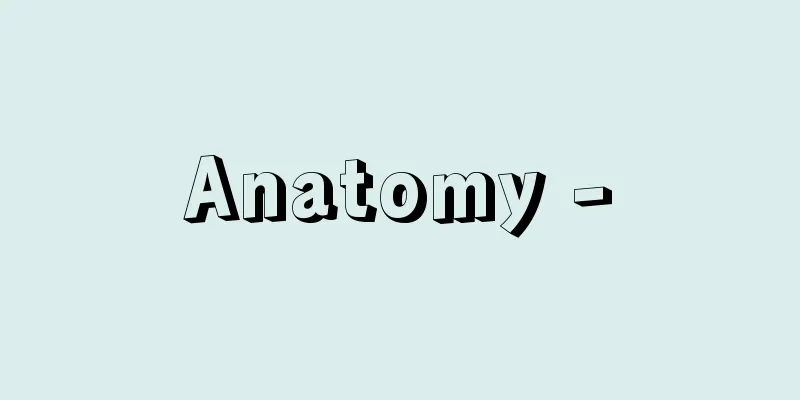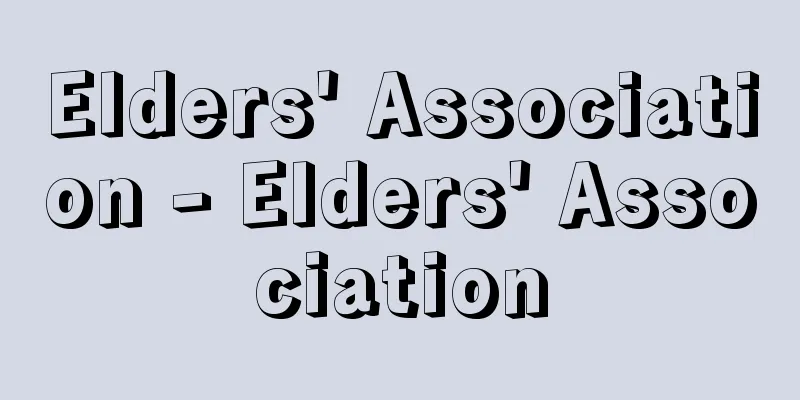Anatomy -

|
Anatomy is a science whose main purpose is to examine the arrangement, interrelationships, and structure of tissues and organs in living organisms through dissection. Since it involves observing the form of living organisms, it is sometimes included in morphology. Depending on the subject, anatomy can be divided into human anatomy, animal anatomy, and plant anatomy (see below), and when comparisons between various animals and plants are emphasized, it is called comparative anatomy. Anatomy can also be divided into various types based on the method used. Human and animal anatomy include macroscopic anatomy (macroanatomy), which examines structures while dissecting with the naked eye, and microscopic anatomy (also called histology), which examines the fine structure of tissues and organs using optical and electron microscopes. Regional anatomy is the study of the relationships between organs in certain parts of the human body, and plays an important role in clinical diagnosis and surgery. In addition, there is surface anatomy, which studies the relationship between the external changes of the human body and its internal structure, and is also called artistic anatomy because it forms the basis of sculpture and painting. Regional anatomy can also be divided into osteology, ligamentology, myology, neurology, vascularology, viscerology, etc., depending on the tissues and organs that are studied. Recently, with the development of electron microscopes and CT (computed tomography), it has become possible to study ultrafine structures and structures in conditions close to the living state. This has resulted in a tremendous increase in anatomical knowledge and a dramatic trend toward subdivision. [Kazuyo Shimai and Sadao Yasugi] Development of AnatomyAnatomy is one of the oldest academic disciplines, and there are records of human dissections in the Papyrus Edwin Smith, an ancient surgical document written in Egyptian hieroglyphics (before 1700 BC), but they are all fragmentary. It is said that the logical approach to anatomy began in ancient Greece. Athens became the center of anatomy around 400 BC, and the famous Collected Works of Hippocrates, written around 340 BC, contains a representative treatise on Athenian anatomy. However, the treatise is developed on humoral theory, and it is unclear whether it is based on human dissection. Although Aristotle did not dissect humans, he dissected many animals, founded comparative anatomy, and made many outstanding achievements, especially in embryological research. After Athens, Alexandria in Egypt became the center of the rise of science, and anatomy came to be included in the academic system. During this period, Herophilos, known as the "father of anatomy," appeared (around 300 BC). Herophilos is said to have dissected both animals and humans, and left behind a wide range of anatomical works, including recognizing the brain as the central organ of the nervous system, distinguishing between motor and sensory nerves, describing the meningeal venous sinuses, distinguishing between the cerebrum and cerebellum, describing the ventricles, prostate, duodenum, and lacteal ducts, distinguishing between arteries and veins, and describing the uterus. This was also the time when Erasistratus, known as the "father of physiology," appeared, and through animal dissections, he came up with various theories about bodily movements. He added original observations about the heart and blood vessels. During the Alexandrian period, even though human dissections were performed, prejudice against dissection and the accompanying speculation and slander were deeply rooted. Galen, an ancient physician and the greatest figure after Hippocrates, is an indispensable figure in ancient anatomy. Galen mainly dissected animals, especially monkeys, and left behind a large number of writings, but his anatomical theories are said to reflect his own philosophical ideas. One of his famous works is "The Art of Dissection." Some of Galen's anatomical knowledge and physiological theories were inherited from the mid-16th century to the 17th century. Galen died around 199, and after that, anatomy came to a complete halt and its progress halted. One of the reasons for this is that Galen believed that all things on earth and in the universe were created by God, and this idea coincided with the doctrine of Christ, so his anatomical and physiological theories were mythologized and worshipped throughout the Middle Ages. In the 13th century, many universities were founded in Europe. However, the University of Bologna had already established a medical department in 1156, and dissection was a regular part of the curriculum by the end of the 13th century. Mondino, a professor at the University of Bologna, wrote Anatomy in 1316 and was called the reviver of anatomy. His anatomical book did not necessarily lead to the modern anatomical system, but it had a great influence until the late Middle Ages (around 1500). In the 15th century, historically famous artists appeared, and these artists had experience in dissection in order to accurately depict the human form. The most famous was Leonardo da Vinci, who left behind accurate anatomical illustrations based on human anatomy. Da Vinci's drawings of the human skeleton, the expression of muscles, and the anatomical diagram of the heart are so brilliant that even anatomists cannot match their observations. It was Vesalius who systematized anatomy in a way that would lead to modern anatomy, completing his work On the Structure of the Human Body (Fabrica) (1543), which cemented his reputation as an anatomist. Vesalius, who wrote such a great work, is said to have had surprisingly few opportunities to actually perform dissections. After the 16th century, the supply and availability of anatomical bodies became more stable, and anatomy rapidly developed into modern anatomy. Comparative anatomy, like the development of modern anatomy, emerged in the 16th century as a merger between natural history and anatomy. French naturalists G. Rondolet (1508-1566) and P. Belon (1517-1564) studied marine animals and birds and achieved pioneering results in this field. Comparative anatomy then flourished during the time of Cuvier. Influenced by Darwin's theory of evolution, Haeckel linked comparative anatomy and comparative embryology to the theory of evolution. [Kazuyo Shimai and Sadao Yasugi] The origins of Japanese anatomyIt is said that human dissections were first performed in the East during the Song Dynasty (980-1126) in China, and there are well-known anatomical books such as the Oukifan Five Organs Diagram and the Sonshin Kanchuzu Diagram. Japanese medicine also developed based on the medicine that was introduced from mainland China, and many medical books were imported and Japan's own medical books were also written. It can be said that human dissections were started by Yamawaki Toyo in the mid-18th century. Yamawaki Toyo had doubts about the internal structure of the human body that had been passed down until then, and tried dissecting animals, but the problem was still not solved. For this reason, he realized the need to directly examine the inside of the human body, and continued to wait for an opportunity to dissect a human body. In 1754 (4th year of the Horeki era), Yamawaki Toyo learned that a death row inmate was going to be executed in Kyoto, and with official permission, he was able to attend the dissection of the executed body and see it in action. The records of that time were compiled in a book called Zoji. Although this book contains many errors from the perspective of today's anatomical studies, it became a major factor in strongly emphasizing the importance of dissection. Even at the time, the ideological influence of the Taiho Code, which banned the dissection of the human body, remained, and harming or dissecting a corpse was considered an inhumane and absurd act, making dissection extremely difficult. However, Yamawaki Toyo's passion for learning overcame these obstacles and motivated the Kyoto Shoshidai (deputy governor) at the time. This marked the beginning of widespread dissection in Japan. The completion of Kaitai Shinsho marked the beginning of Japanese anatomy as an academic discipline. On March 4, 1771 (Meiwa 8), Sugita Genpaku, Maeno Ryotaku, Nakagawa Junan and others observed the dissection of a female executed body at the Kozukahara execution grounds in Edo. They were so impressed by the accuracy of the contents of the Dutch anatomical book Tafel Anatomie that they used as a reference, that they decided to translate the book. Other comrades, including Katsuragawa Hoshu and Ishikawa Genjo, assisted in the translation work, and in 1774 (Anei 3), the five-volume Kaitai Shinsho was completed, consisting of four volumes of the main text and one volume of illustrations. From this point on, Japanese anatomy also made great strides. Sugita Genpaku's Rangaku Koto Hajime (The Beginnings of Dutch Studies) contains a detailed account of the circumstances leading up to the creation of Kaitai Shinsho. [Kazuyo Shimai] Plant AnatomyPlant histology is a science that clarifies the internal structure of plants. Thin sections of several tens of micrometers are made using a microtome (a machine that slices samples to a certain thickness), and the types, shapes, and arrangements of cells are observed and described microscopically. The first clear observations of the internal structure of plants were made by Grew of England and Malpighi of Italy. Since then, plant anatomy has developed in two directions: one that emphasizes physiological background, and the other that takes a taxonomic stance based on comparative research. However, just as modern anatomy does not only study the internal structure of adults, plant anatomy is often referred to in a broad sense in recent times as including not only the fields of plant embryogenesis and morphogenesis, but also cytology, which clarifies the internal structure of cells. Plant morphology refers to both anatomy and organology, which aims to elucidate the external structure. [Akiko Sugiyama] "A Brief History of Anatomy and Physiology" by Charles Singer, translated by Nishimura Kenji and Kawana Etsuro (1983, Hakuyosha)" ▽ "The History of Medicine" by Ogawa Teizo (Chuko Shinsho) ▽ "Anatomy of the Body (Modern Japanese Translation)" by Sakai Shizu (Kodansha Academic Library) [References] | | | | | |Source: Shogakukan Encyclopedia Nipponica About Encyclopedia Nipponica Information | Legend |
|
解剖によって生物体の組織や器官の配置、相互関係、および構築を調べることを主要な目的とする学問をいう。生物体の形態を観察することから、形態学のなかに包括する場合もある。解剖学は対象によって、人体解剖学、動物解剖学、植物解剖学(後述)に分けることができ、また、各種の動物および植物についての比較が強調される場合は、比較解剖学とよばれる。解剖学はまた、その方法によってもいろいろに分けられる。人体解剖学、動物解剖学には、肉眼で解剖しながら構造を調べる肉眼解剖学(巨視解剖学)と、光学顕微鏡、電子顕微鏡によって組織や器官の微細な構造を調べる顕微鏡的解剖学(組織学ともいう)がある。 人体のある局所の臓器の相互関係を調べる解剖学が局所解剖学で、臨床上、診断や外科的手術の際に重要な役割を果たす分野である。そのほか、人体の外形変化と内部構造との関係を研究する体表解剖学があり、彫刻や絵画の基礎となるため、芸術(美術)解剖学ともよばれる。また、対象とする組織や器官によって、骨学、靭帯(じんたい)学、筋学、神経学、脈管学、内臓学などに分けられる。 最近は電子顕微鏡、CT(コンピュータ断層撮影法)などの発達によって、超微細構造が対象となったり、生存状態に近い状態で構造を調べる条件が整い、解剖学の知識はおびただしく増加し、細分科の傾向が甚だしくなっている。 [嶋井和世・八杉貞雄] 解剖学の発展解剖学は、もっとも古くから行われてきた学問の一つで、エジプト象形文字で書かれた『パピルス・エドウィン・スミス』という古い外科学の文献(紀元前1700以前)には、人体解剖の記録がみられるというが、いずれも断片的なものである。解剖学が、論理的な方法で始まったのは、古代ギリシアからといわれている。紀元前400年ころからアテネが解剖学の中心となり、紀元前340年ころの有名な『ヒポクラテス全集』中にも、アテネ解剖学の代表的な論文が載せられている。しかし、論文は体液論で展開されており、人体解剖に基づいているかどうかは不明である。アリストテレスは、人体の解剖は行っていないが、動物の解剖を数多く行い、比較解剖学を創設し、とくに発生学的研究に優れた業績が多い。 アテネののちは、エジプトのアレクサンドリアが科学興隆の中心となり、解剖学も学問体系のなかに包含されるようになった。この時代に「解剖学の祖」といわれるヘロフィロスが出ている(紀元前300ころ)。ヘロフィロスは、動物と人体の両方を解剖した人物といわれ、脳を神経系の中枢器官と認め、運動神経と感覚神経の区別、髄膜(ずいまく)(脳膜)静脈洞に関する記載、大脳と小脳の区別、脳室、前立腺(せん)、十二指腸、乳糜(にゅうび)管の記載、動脈と静脈の区別、子宮の記載といった、多彩な解剖学上の仕事を残している。また、この時代には「生理学の祖」といわれるエラシストラトスも現れ、動物の解剖を通じて、身体の動きについてのさまざまな理論を考えた。彼によって、心臓や血管についての独創的な考察が加えられている。アレクサンドリア時代には、人体の解剖が行われたにもかかわらず、解剖に対する偏見や、これに伴う憶測や中傷も根強かった。 古代の医師で、ヒポクラテス以後の最大の傑出者といわれるガレノスは、古代解剖学では忘れることができない人物である。ガレノスはおもに動物、とくにサルの解剖を行い、膨大な著作を残したが、彼の解剖学理論には、独自の哲学的思想が反映しているとされる。名著に『解剖手技』がある。ガレノスの解剖学上の知識や生理学的理論のなかには、16世紀なかばから17世紀にまで受け継がれたものもある。ガレノスは199年ころに死んだが、その後は解剖学もまったく終息した形となり、その進歩は止まってしまった。その理由の一つは、ガレノスが地上および宇宙にある事物は、すべて神によってつくられたという考え方をもっており、この思想がキリストの教義と一致したため、中世を通じて、彼の解剖学的ないしは生理学的理論が神話化され、信奉されたことによる。 13世紀になり、ヨーロッパには数多くの大学が創設された。しかし、ボローニャ大学では、それ以前の1156年にはすでに医学部が設けられており、13世紀末には解剖は普通のカリキュラムとなっていた。ボローニャ大学教授のモンディノは、1316年『解剖学』を著し、解剖学の再興者とよばれた。彼の解剖書は、かならずしも近代の解剖学体系につながるようなものではないが、中世後期(1500ころ)までは大きな影響を与えた。15世紀になると、歴史的に有名な芸術家たちが輩出したが、これら芸術家は、人の形態を正確に表現するために解剖の経験をもっていた。もっとも有名なのがレオナルド・ダ・ビンチで、人体解剖に基づいた正確な解剖図譜を残している。ダ・ビンチの描いた人体骨格図、筋の表現様式、心臓の解剖図などは、解剖学者も及ばないほどのみごとな観察である。近代解剖学につながるような解剖学を体系づけたのはベサリウスで、『人体の構造について(ファブリカ)』(1543)を完成させ、彼の解剖学者としての名声を不朽のものとした。こうした大著を物したベサリウス自身は、実際の解剖を行った機会は、案外に少ないとされている。16世紀以降になると、解剖体の供給、入手も安定するようになり、解剖学は急速に近代解剖学へと発展していった。 比較解剖学は、近代解剖学の発展と同様、16世紀になって博物学と解剖学が合流する形で出現した。フランスの博物学者であるロンドレG. Rondolet(1508―1566)やブロンP. Belon(1517―1564)は、海産動物や鳥類を研究し、この分野での先駆的な業績をあげている。その後キュビエのころに比較解剖学は隆盛を極めた。また、ダーウィンの進化論の影響を受けて、ヘッケルは比較解剖学、比較発生学と進化論を関連づけた。 [嶋井和世・八杉貞雄] 日本の解剖学のおこり東洋において人体の解剖が行われたのは中国の宋(そう)代(980~1126)とされ、『欧希範(おうきはん)五臓図』『存真環中図(そんしんかんちゅうず)』などの解剖書が知られている。日本の医学も、こうした中国大陸から渡来した医学をもとに発展したものであり、多くの医書が輸入され、日本独自の医書も著された。人体解剖は18世紀なかばの山脇東洋(やまわきとうよう)によって始められたといえる。山脇東洋は、それまで言い伝えられてきた人体内部の構造に疑問をもち、動物解剖なども試みたが、なお問題は解決されなかった。このため、直接人体の内部を確かめる必要を悟り、人体解剖の機会を待ち続けた。1754年(宝暦4)京都において死刑囚の刑の執行があることを知った山脇東洋は、公の許しを得て刑死体の解剖に立ち会い、その実際を見ることができた。そのときの記録をまとめたのが『蔵志』という書である。この書は、今日の解剖学からみれば誤りも少なくないが、解剖がいかに重要であるかを強く主張する大きな因となった。当時にあっても、人体の解剖を禁じた大宝律令(たいほうりつりょう)以降の思想的影響が残っており、死体を傷つけたり、解剖することは非人道的で、不条理な行為と考えられていたため、解剖はきわめて困難な状況にあった。しかし、山脇東洋の学問に対する熱意が、このような難関を越えて、そのときの京都所司代を動かしたのであった。これを機に日本でも盛んに解剖が行われるようになった。 日本の解剖学が学問的体系をもち始めるきっかけとなったのは『解体新書』の完成であった。1771年(明和8)3月4日、杉田玄白、前野良沢(りょうたく)、中川淳庵(じゅんあん)らは江戸の小塚原の刑場で女性の刑死体の腑分(ふわ)けを見学したが、そのとき参考にしたオランダ語の解剖書『ターヘル・アナトミア』の内容の正確さに感動し、この書の翻訳を決意した。翻訳作業には桂川甫周(かつらがわほしゅう)や石川玄常らの同志も協力し、1774年(安永3)本文4巻、図譜1巻からなる5冊の『解体新書』が完成した。これ以降、日本の解剖学も長足の進歩を遂げることになる。杉田玄白の著した『蘭学事始(らんがくことはじめ)』には、『解体新書』ができあがるまでの事情が詳しく記されている。 [嶋井和世] 植物解剖学植物体の内部構造を明らかにする学問で、植物組織学ともいう。ミクロトーム(試料を一定の厚さの切片にする機器)などで数十マイクロメートル前後の薄切片をつくり、顕微鏡学的に細胞の種類、形、配列などを観察し記述する。はっきりとした植物の内部構造を最初に観察したのは、イギリスのグルーとイタリアのマルピーギである。その後、植物解剖学は生理学的背景を重視する方向と、比較研究に基づく分類学的立場をとる方向とに分かれて発展してきた。しかし、近代解剖学が、単に成体の内部構造だけをその研究対象としていないと同様に、最近では、植物の胚(はい)発生、形態形成の分野はもちろん、細胞の内部構造を明らかにする細胞学をも含めて、広義に植物解剖学とよばれることが多い。なお植物形態学とは、解剖学と、外部構造の解明を目的とする器官学の二つをさしている。 [杉山明子] 『チャールス・シンガー著、西村顕治・川名悦郎訳『解剖・生理学小史』(1983・白揚社)』▽『小川鼎三著『医学の歴史』(中公新書)』▽『酒井シズ著『解体新書(現代語訳)』(講談社学術文庫)』 [参照項目] | | | | | | |出典 小学館 日本大百科全書(ニッポニカ)日本大百科全書(ニッポニカ)について 情報 | 凡例 |
Recommend
Lidocaine hydrochloride
...White to pale yellow crystals or crystalline p...
Best, Charles Herbert
Born: February 27, 1899, West Pembroke [Died] Marc...
Hawthorne, Nathaniel
Born July 4, 1804 in Salem, Massachusetts. Died Ma...
Kuroashineko (English spelling) Black-footed Cat
A small carnivorous mammal of the Felidae family w...
Jazz Messengers
...But behind the scenes, there was a group of un...
Entry into the story - Entry into the story
...A general term for those used for the entrance...
Benz - Bentsu (English spelling) Karl Friedrich Benz
German mechanical engineer and one of the invento...
"Patriotic Hyakunin Isshu"
...The leading members were Tokutaro Fujita, Yoju...
Centrifugal force
The outward force that an object experiences when...
Obonkeiso - Obonkeiso
A perennial plant of the Crassulaceae family (APG...
Circular soil - Enkeido
...Soil with gravel structured is classified as s...
Zentobun - All Tang Dynasty Texts
A collection of Chinese prose from the Tang dynas...
Örkény I. (English notation) OrkenyI
...The new writers were influenced by Sarkadi Imr...
Pneumococcus - pneumococcus
〘Noun〙 The causative agent of various suppurative ...
social exchange
...The idea of "reward" and "fav...









